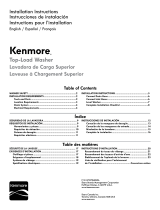
3
Location Requirements
Selecting the proper location for your washer improves
performance and minimizes noise and possible washer “walk.”
Your washer can be installed in a basement, laundry room, closet,
or recessed area. See “Drain System.”
IMPORTANT: Do not install or store the washer where it will be
exposed to the weather.
Proper installation is your responsibility.
You will need:
■ A water heater set to deliver 120°F (49°C) water to the washer.
■ A grounded electrical outlet located within 4 ft (1.2 m) of
where the power cord is attached to the back of the washer.
See “Electrical Requirements.”
■ Hot and cold water faucets located within 3 ft (90 cm) of the
hot and cold water fill valves, and water pressure of 5-100 psi
(34.5-690 kPa). Washers with triple dispensers require
20-100 psi (138-690 kPa) for best performance.
■ A level floor with a maximum slope of 1" (2.5 cm) under entire
washer. Installing the washer on carpeting is not
recommended.
■ A sturdy floor to support the washer weight (washer, water
and load) of 315 lbs (143 kgs).
Do not store or operate your washer in temperatures at or below
32°F (0°C). Some water can remain in the washer and can cause
damage in low temperatures. See “Washer Care” in the Washer
User Instructions for winterizing information.
Recessed area or closet installation
The dimensions shown are for the recommended spacing allowed
(A and B), except the closet door ventilation openings. The
dimensions shown for the closet door ventilation openings (C) are
the minimum required.
■ Additional spacing should be considered for ease of
installation and servicing.
■ Additional clearances may be required for wall, door and floor
moldings.
■ Additional spacing of 1" (2.5 cm) on all sides of the washer is
recommended to reduce noise transfer.
■ If a closet door is installed, the minimum air openings in the
top and bottom of the door are required (C). Louvered doors
with air openings in the top and bottom are acceptable.
■ Companion appliance spacing should also be considered.
Drain System
The washer can be installed using the standpipe drain system
(floor or wall), the laundry tub drain system, or the floor drain
system. Select the drain hose installation method you need. See
“Tools and Parts.”
Standpipe drain system—wall or floor (views A & B)
The standpipe drain requires a minimum diameter standpipe of
2" (5 cm). The minimum carry-away capacity can be no less than
17 gal. (64 L) per minute. A 1¹⁄₄" (3.2 cm) diameter to 1" (2.5 cm)
diameter standpipe adapter kit is available. See “Tools and Parts.”
The top of the standpipe must be at least 39" (99 cm) high and no
higher than 96" (244 cm) from the bottom of the washer.
To avoid siphoning, no more than 8" (20.3 cm) of drain hose
should be inside the standpipe. Secure drain hose with beaded tie
strap.
Laundry tub drain system (view C)
The laundry tub needs a minimum 20 gal. (76 L) capacity. The top
of the laundry tub must be at least 39" (99 cm) above the floor and
no higher than 96" (244 cm) from the bottom of the washer.
Floor drain system (view D)
The floor drain system requires a siphon break that may be
purchased separately. See “Tools and Parts.”
The siphon break must be a minimum of 28" (71 cm) from the
bottom of the washer. Additional hoses might be needed.
To avoid siphoning, no more than 8" (20.3 cm) of drain hose
should be below the top of the wash tub. Secure drain hose with
beaded tie strap.
A. Front view
B. Side view
C. Closet door with vents
A
B
C
19"
(48.3 cm)
0"
(0 cm)
0"
(0 cm)
27"
(68.6 cm)
1"
(2.5 cm)
25
¹⁄₂"
(64.8 cm)
4"
(10.2 cm)
14" max.
(35.6 cm)
3"
(7.6 cm)
3"
(7.6 cm)
24 in.
(155 cm )
2
2
48 in.
(310 cm )
2
2
A
B
39"
(99 cm)
C
D
39"
(99 cm)
28"
(71 cm)








